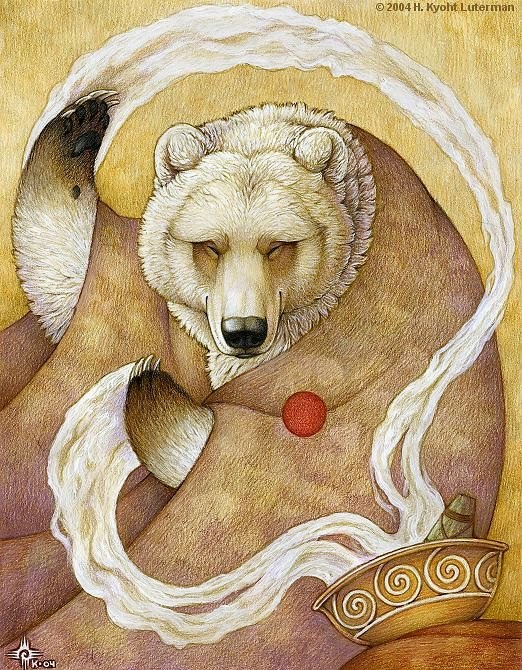LEGEND OF THE BEAVER MEDICINE
Evening in Mad Wolf's lodge.—His fatherly talk.—He tells the origin of the Beaver Medicine.—In the legend, Nopatsis, jealous of Akaiyan his younger brother, leaves him to die on a lonely island.—The chief of the Beavers rescues him and keeps him all winter in the lodge of the Beavers.—Teaches him the ceremonial of the Beaver Medicine and the make-up of the Beaver Bundle, and bestows upon him supernatural power.—His youngest child, Little Beaver, returns with Akaiyan to the Blackfoot camp to help in teaching the people.—He creates the Beaver Medicine, to which many birds and animals contribute their power.
Artist: Sue Coleman
RETURNING to Mad Wolf's lodge I found him reclining upon his blankets, resting after the strain of the services. There was a long silence, which I did not venture to break, nor to disturb him, while smoking with half-closed eyes. Meanwhile the deepening twilight, which in a northern latitude comes quickly after sunset, but lingers, had settled over prairie and camp. As I looked upon the sacred Beaver Bundle, lying by his side in the flickering light of the small fire, I thought of their mysterious power over the Indian mind and life, and of the strange superstitions centred about them, which had been handed down through many generations. I was aroused from my reverie by Mad Wolf knocking the ashes from his pipe. He looked at me intently for a few moments. His manner was earnest and dignified, and as he sat erect, his long black hair fell loosely over his shoulders. He answered my inquiring look towards the Medicine Bundle by signing to me that I should grasp one end of the rope. We together removed the cover that hid it from view. He allowed me to gaze upon the sacred Bundle for a moment when the robe was solemnly replaced. He then began to speak in a low voice, with eyes half closed, as if gazing into the far distance, saying: "When I was a young man, I too became interested in the mysteries of the medicines, which have been taught to me by old Indians, and what they have told me I know to be true. I have never before explained those mysteries to white men because I have always been afraid to trust them. I am now willing to have you repeat these to the white race because I know that you will speak the truth and because I feel toward you as a father to his son. When I bought the Beaver Medicine from O-mis-tai-po-kah, there came with it a very old pipe, which now lies by its side. I will not smoke this pipe for it brings bad luck. When O-mis-tai-po-kah smoked it his children began to die, so I preserve it only as a relic. There was a time when I had many relics. If I had them now I would give them to you, but they are gone."
He handed me the two rattles I had used in the ceremonial and a small buckskin sack, saying,
"In it are some of the original seeds of the tobacco given to us by the beavers. They were secured many years ago by Akaiyan, the man who lived all winter in the lodge with the chief Beaver and brought back with him the Beaver Medicine. I will relate to you the story as it has been handed down from our ancestors. What I will tell you happened long ago, when our people made all of their tools and weapons from stone, and when they used dogs instead of horses for beasts of burden."
THE ORIGIN OF THE BEAVER MEDICINE
"In those days there were two orphan brothers. The younger, named Akaiyan (Old Robe), lived with his brother Nopatsis, who was married to a woman with an evil heart. This woman disliked Akaiyan and continually urged her husband to cast him off. One day when Nopatsis came home, he found his wife with her clothes torn and her body lacerated. She explained that, during his absence, Akaiyan had treated her brutally. Nopatsis said nothing to his younger brother but planned how he might be rid of him forever. It was midsummer, the time when the ducks and geese dropped their feathers. He proposed to Akaiyan that they should go together to an island in a large lake and said, 'At this time there will be many ducks and geese there, and we can gather the feathers they have dropped to be used for arrows.' When the brothers came to the lake they built a 'skatstan' (raft), binding together logs with buffalo rawhide and then floated on it to an island, far out in the lake. As they walked along the shores of this island looking for feathers, Akaiyan wandered off alone. He was returning with his arms full, when he beheld his brother out on the lake, going towards the shore of the mainland. He implored Nopatsis not to abandon him to perish on the lonely island. But his brother only called back, that he deserved no pity because of his brutal treatment of his sister-in-law. Akaiyan besought him to return, solemnly declaring before the Sun that he had not injured her. But Nopatsis replied heartlessly, 'You can live alone on the island all winter. In the spring, when the ice melts in the lake, I will return to gather your bones.' Akaiyan sat down and wept. He thought his time had come to die. Then he called upon the animals and the underwater spirits for assistance. He also prayed to the Sun, Moon and Stars, saying,
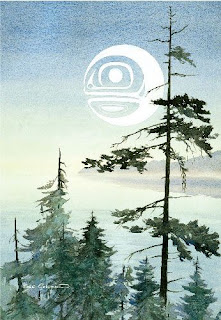
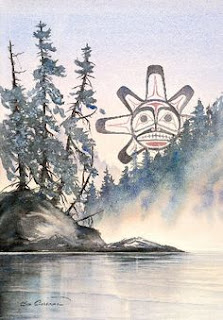
'Haiyu! Mistapixit Mekape Natotsichpi!'
Behold, O Sun! I cast away whatever of bad I have done.'
'Kokumekis! Kokatosix Kummokit Spummokit!'
'O Moon! O Stars! pity me! Give me strength!
"After this prayer Akaiyan felt relieved and strengthened. He walked around the island and found a few branches, with which he made a shelter. He also gathered many loose feathers, piling them up and making a bed that fitted his body so well that he slept warmly on the coldest nights. He killed many ducks and geese before their time for leaving the island to fly south, shooting the wild ones with his arrows and striking the tame ones upon the head with long sticks. He kept some for his winter food, but he skinned others and made a warm robe for himself by binding the skins together with alder bark.
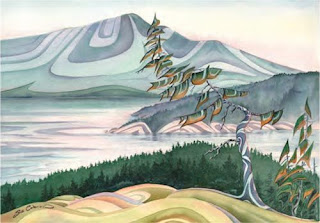
"One day, when he discovered a beaver lodge, he lay for a long time watching it and weeping, to himself, because he had been abandoned. Finally, a little beaver came from the lodge, and said to him, 'My father wants you to come into his lodge.' Akaiyan followed the little beaver into the lodge, where he saw a big beaver with his wife and family seated around him. This beaver was white from the snows of many winters and so large that Akaiyan knew he must be the chief of all the beavers.

The Beaver Chief bade him be seated, and asked him why he was living alone on the island. Akaiyan told him how cruelly and unjustly he had been treated and left alone to die. The Beaver Chief pitied Akaiyan and counselled with him, saying, 'My son, the time will soon when we will close up our lodge for the winter. The lake will freeze over and we cannot come out again for seven moons. Until the warm winds of spring will break up the ice we will remain in our lodge. While the snows are deep we will teach you many wonderful things and when you return again, you can take knowledge with you. This will be of great value to your people.'

The beavers were so hospitable, Akaiyan decided to remain with them. He took with him into the beaver lodge many ducks and geese for food and his bird-skin robe to keep him warm. They closed their lodge before it became cold, leaving a hole for air at the top. During the coldest days, the beavers kept Akaiyan warm by lying close to him and placing their tails across his body. He made friends with all of them, but he liked the youngest and smallest beaver best of all. He was the cleverest as well as the favourite child of the Beaver Chief.
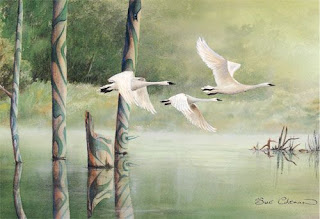
Akaiyan learned their habits and manner of living. They taught him the names of the herbs and roots, which we still use for the curing of the people. They showed also him the different paints, and explained their use, saying, 'If you should use these, they will bring your people good luck and will ward off sickness and death.' They gave him the seeds of the tobacco (origin of tobacco story) and taught him how they should be planted with songs and prayers. They made scratches with their claws on the smooth walls of the lodge to mark the days, and when the days completed a moon they marked the moons with sticks. He witnessed many dances belonging to their medicines and listened carefully to the songs and prayers. The Beaver Chief and his wife (Wise Old Woman) taught him the prayers and songs of their medicine and the dances that belonged to them, and said, 'Whenever any of your people are sick or dying, if you will give this ceremonial, they will be restored to health.' He noticed that the beavers never ate during the ceremonial, and that they beat time for the dances with their tails, always stopping when they heard any suspicious noise, just as they do when they are at work. They told him that they counted seven moons from the time when the leaves fall before they prepared to open their lodge in the spring. When they heard the booming of the ice breaking in the lake, they knew it would soon be time to leave their winter home.
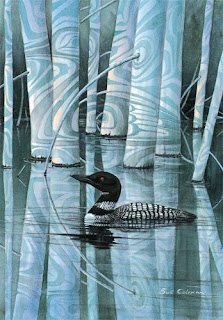
"Little Beaver told Akaiyan that, before he parted with them, his father, the Beaver Chief, would offer him a present and would allow him to choose anything within the lodge. Little Beaver also advised him, saying, 'When my father asks you for your choice, say that you will take your little brother. He will not be willing to part with me, for he prizes me above everything he owns. He will ask you four times to choose something else, but take me with you, for I will have more power to help you than any of the others.'
"The ducks and geese were flying north, when the beavers finally opened their lodge for the summer, and the Beaver Chief said to Akaiyan, 'You will soon leave us now, because it is time for your older brother to return. But, before you start, I will allow you to choose anything in my lodge to take away with you.' Then Akaiyan, remembering the advice of Little Beaver, asked for his youngest child. The Beaver Chief made many excuses and endeavoured to persuade him to take something else, but Akaiyan would have no other gift. After the fourth trial, the Beaver Chief said, 'My son, you show your wisdom in selecting your little brother to go with you. I am sorry to part with him, because he is the best worker and the wisest of my children, but, because of my promise, I now give him to you.'
"The Beaver Chief also told Akaiyan that, when he returned to his people, he should make a sacred Bundle similar to the one he saw them using in their ceremonial. He also taught him the songs and prayers and dances that belonged to the Bundle and informed him that, if any of the people were sick or dying and a relative would make a vow to the Beaver Medicine, the sick would be restored to health.
"One evening, when the Beaver Chief returned from his cutting, he said to
Akaiyan, 'My son, remain in hiding and do not show yourself. Today, when I was among the trees on the main shore, I saw your brother's camp.' The next day Akaiyan, watching from the beaver lodge, saw Nopatsis coming to the island on the raft. He saw him land and walk along the shore hunting for his bones. Then Akaiyan ran, with Little Beaver under his arm and took possession of the raft. He was far out in the big lake before Nopatsis saw him, He at once realised that his younger brother had secured power superior to his own and had become a great medicine, man.

"Akaiyan now returned with Little Beaver to the tribal camp. He went at once to the head chief's lodge and told his story. All the people received him with the greatest honour when they heard of the wisdom and power that had been given him by the Beavers. Akaiyan gathered together a Beaver Bundle as the Beaver Chief had directed. He and Little Beaver had remained all winter in the camp, teaching the people the songs, prayers and dances given him by the beavers. When Spring came, Akaiyan invited all of the animals to add their power to the Beaver Medicine. Many birds and animals of the prairies and mountains came, offering their skins and taught him their songs, prayers and dances to accompany their skins, just as the beavers had done. The Elk and his wife each contributed a
song and dance, also the Moose and his wife. The Woodpecker gave three songs with his dance. The Frog alone of all the animals could neither dance nor sing, and it is, for this reason, he is not represented in the Beaver Bundle. The Turtle could not dance and had no song, but is represented in the Bundle, because he was wise and borrowed one from the Lizard, who owned two songs.

"In the following spring Akaiyan returned to the island with Little Beaver to visit the beaver lodge. He saw his brother's bones on the shore and knew the beavers had not helped him. The Beaver Chief welcomed Akaiyan warmly and when he gave back Little Beaver to his father, the old chief was so grateful that he presented him with a sacred pipe, teaching him also the songs, prayers and dances that belonged to it. When Akaiyan returned again to the Indian camp he added this pipe to the Beaver Bundle. Every spring Akaiyan went to visit his friends, the beavers, and each time the Beaver Chief gave him something to add to the Beaver Bundle until it reached the size it has to-day. Akaiyan continued to lead the Beaver ceremonial as long as he lived and was known as a great medicine man. When he died, the ceremonial was continued by his son and has been handed down ever since."
